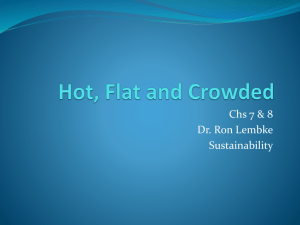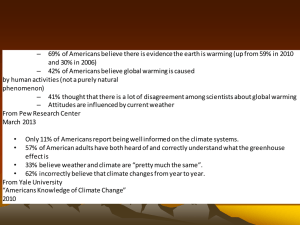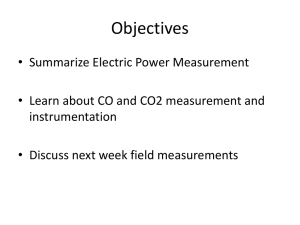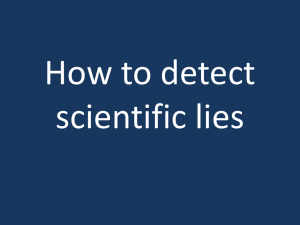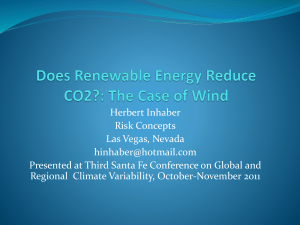Temperature Increase
advertisement
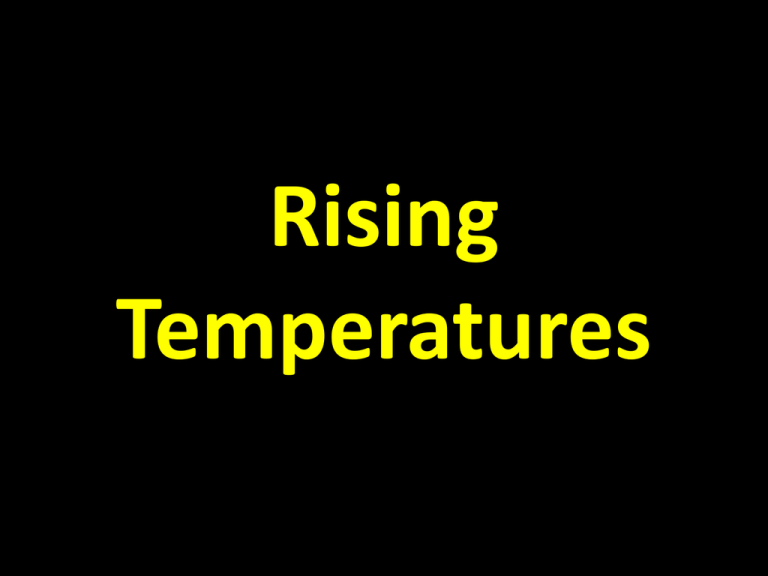
Rising Temperatures Various Temperature Reconstructions from 200-2008 Arctic Air Temperatures from Proxies (blue) and Observed Temperatures (red) Temperatures from Proxies and Instruments for Last 1,800 Years • The current temperature rise is unprecedented • It coincides with the Industrial Revolution and the exponential population growth • It also coincides with the rapid rise in greenhouse gas emissions Radiative and Net Climate Forcing (1880-2006) Temperature Anomaly (1880-2009) Base: 1951-1980 Aerosols Aerosols Aerosols Hemispheric Temperature Anomaly (1880-2009) Base: 1951-1980 5-year and 11-year Monthly Mean Temperatures for the Entire Earth and the Northern (N.H.) and Southern (S.H.) Hemispheres. (Base is 1951-1980) Temperature Change from 1850-2009 • Mean surface temperature change for 2001-2007 relative to the 1951-1980 base (top). • Global average temperature 1850-2009 relative to the baseline period 1880-1920 estimated from NASA/GISS data set (red) and the Hadley data (blue). • The final bold point is estimated for 2009. Temperature Trend 1983-2008 Global Temperature Index for 5and 11-year Running Mean Hottest Years Ranked by the British Meteorological Office The Current Decade Was the Hottest Variations of the Arctic Oscillation that are responsible for cold Arctic air reaching lower latitudes (negative values). The extreme negative oscillation for Dec. 2009 is shown. IPCC Projected Temperature Rise Temperature, CO2 Concentrations and Carbon Emissions Temperature Increase 1992-2004 • The yellows and reds on these world maps are positive (warm) anomalies while blues are negative (cool) anomalies. • The greatest amount of heating has occurred generally in the Northern Hemisphere and specifically in the Arctic regions. Temperature Anomaly for 2007 CO2 and Temperature Stabilization Percent Change in global emissions CO2 (ppm) CO2-eq. (ppm) Year of Peak Emissions Global average temperature increase above pre-industrial at equilibrium, using “best estimate” climate sensitivity CO2 concentration at stabilization (2010 = 388 ppm) CO2-eq. Concentration at stabilization including GHGs and aerosols (2008 = 395 ppm) Peaking year of CO2 emissions Change in CO2 emissions in 2050 (percent of 2000 emissions) 2.0-2.4 350-400 445-490 2000-2015 −85 to −50 2.4-2.8 400-440 490-535 2000-2020 −60 to −30 2.8-3.2 440-485 535-590 2010-2030 −30 to +5 3.2-4.0 485-570 590-710 2020-2060 +10 to +60 4.0-4.9 570-660 710-855 2050-2080 +25 to +85 4.9-6.1 660-790 855-1130 2060-2090 +90 to +140 Temperature Rise (°C) Data from: IPCC, 2007:Synthesis Report. Temperature Anomaly at CO2 Stabilization Relative to 1800 Only Human-caused Greenhouse Gas Emissions Can Account for Global Warming • The black line is the observed temperature rise. • The red area is computer simulations of all emissions, including human. • The blue area is computer simulations of only natural emissions and the increase in solar activity. Rise in the Ocean Heat Content The Warming Oceans Earth’s Heat Gain During the Past 21 50 years (10 Joules*) •Oceans = 145 (84%) •Continents = 10.4 (6%) •Earth’s Ice = 8.1 (5%) •Atmosphere = 6.6 (4%) *A joule is a unit of heat energy What Global Average Temperatures Become Critical and Catastrophic for Humans? • The current best estimate is 2° C above pre-industrial levels is potentially critical. About 4° C is potentially catastrophic. The Earth is now 0.8° C above pre-industrial levels. • When the CO2 abundance reaches ~450 ppm the temperature anomaly will eventually exceed 2° C. At ~650 ppm it will eventually reach a minimum of 4° C. • The current abundance (2010) is 388 ppm and rising at a rate of ~2 ppm/year, and this rate is increasing. • We have about 30 years to stabilize the greenhouse gas abundance by cutting emissions ~70% (~80% for CO2 only). Even at today’s abundance the temperature anomaly will reach the critical level in about 40 years. WHAT IS CRITICAL AND WHAT IS CATASTROPHIC? • CRITICAL --- serious drop in food production, serious water shortages, significant sea level rise, political unrest, major drop in world GDP, major animal extinctions and millions of human deaths. Third-world countries, e.g. Africa, are affected most, including large human migrations. • CATASTROPHIC --- mass extinction event (>50% species extinction), major sea level rise, mass starvation, political and economic chaos, ~50% human deaths (>3 billion people). Probably the end of civilization as we know it today. Atmospheric Abundance of CO2 and Global Temperatures CO2 (ppm) Average Global Temperature (°C) 180 9 Last Ice Age Maximum 280 13 Interglacial Period (Holocene) 350 14 Upper Limit to Preserve Ice Sheets 387 14.6 450 16 Critical for Humans and Other Species 650 ~20 Catastrophic for Humans and Other Species ~1500 ~25 Hot House Maximum Event Today Possible CO2 Concentrations and Temperature Increases Possible Temperature Rise Projected Temperature Rise for Additional Greenhouse Gases (GHGs) Added CO2 Equivalent for Other GHGs Warming or Cooling for CO2, Other GHGs and Aerosols Past and Future Temperatures






